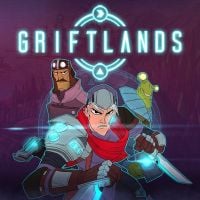Griftlands: Folding a deck of cards in Griftlands
Last update:
In this section of our guide to Griftlands, you will learn about the types of cards and their distribution. You will also learn about the effects and synergies commonly used in Griftlands. At the end we will provide info about several types of decks and explain the principle of their operation.
Cards
In Griftlands we have two separate decks. One for negotiations and one for duels. At the beginning of the game we receive a set of two basic decks. You can see them when you start a new game. Each deck has its own types of cards. Each set has a different background color and an icon on the left side of the card name. We distinguish the following groups of cards:
- Diplomacy; it is a group of negotiation cards. They have a bright green background. They work well with other cards in this group. Their main strength are Influence points, which allow you to deal maximum damage when using cards of this group. It also allows you to play additional bonuses in exchange for the loss of these points.
- Hostility; it is a group of negotiating cards. They have a red background. They work well with other cards from the same group. They focus on playing a large number of cards and dealing bonus damage through Dominace, increasing the damage by 1 point on all cards in this group.
- Manipulate; it is a group of negotiation cards. They are characterized by a purple background. They complement cards from the Dimplomacy and Hostility groups. They mainly rely on gaining Composure, the armor for our arguments, which takes up some of the received damage.
- Attack; it's a group of duel cards. They have an orange background. They focus on injuring enemies and putting on them some debuffs in form of damage over time weakening effects. You can also use them to earn Combo Points, which allow you to use additional card effects.
- Maneuver; this is a group-card for duels. They have a blue background. They focus on gaining Defence, which is an armor that will protect you from some of the damage, and drawing cards.
- Item; this is a card group that occurs in both decks. They have a dark green background. They can usually be used from 1 up to 3 times. You can get them while performing tasks or buy them from shopkeepers.
- Status; this is a group of cards that can be seen in both types of decks. They are characterized by a yellow background. These cards get into our deck either by performed actions or as a result of opponent's skills. These cards are not desired in our decks. These can significantly complicate the game and such situation may occur quite often.
All cards have a rarity level. These can be distinguished by the color of the frame. The first are the Basic cards, which player gets in the beginning of the game. Then you have Common, Uncommon, Rare and Unique cards at your disposal. They differ in the availability and price if you decide to buy them from a trader in the in-game store.
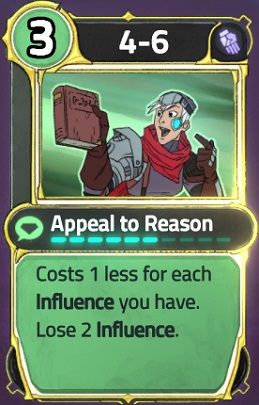
Each of these cards has unique and additional features. In the upper left corner you can see the number of action points necessary to play the card. In the right one you can see the symbol of the deck to which it belongs. This is especially useful when you choose one of the three cards to be included in your deck. There is a damage interval in the middle of the card. Under the picture you can see the name of the card. To the left is the symbol of the group to which the card belongs. Below you can see the experience bar of the card. If you play this card a sufficient number of times, you can improve it in one of the two evolutionary ways. At the bottom there is a space in which card features are described. When you move your cursor over bold phrases, you can check the additional information.
An important issue is the possibility of acquiring new cards. At the beginning of the game you receive them for completing tasks and for winning duels or negotiations. Also, you can receive them as a gift if you have a good relationship with a character, or buy them from shopkeepers, mainly from the item group. In the evening, at the end of the first day, you get access to the Roadsite market. You can buy negotiation cards, duel cards and graphs to your armor.
Effects and card features
Most of the cards in your deck have some additional effects except for pure damage. An exception to this is the Basic card from the basic set, but even those that have been upgraded receive additional abilities. We provide detailed information of card effects and card abilities in the list below:
- Influence - All cards in the Diplomacy group deal maximum damage. These points can also be used to play other cards to activate their actions.
- Composure - Your arguments during negotiations receive an armor that blocks incoming damage. The points of that armor disappear after one round.
- Domination - Your Hostility cards deal one more damage point. At the beginning of the turn decrease the number of Domination points by one.
- Evoke - Play a card from a hand or a set of cards drawn for free when the conditions on the card are fulfilled.
- Heated - At the end of a turn cause 1 point of resolve damage to a random argument and then increase the number of points by 1.
- Flustered - Reduces resolve damage by 33%. At the end of the round, reduce the number of Flustered points by 1.
- Improvise - After playing a card you choose one from a few random cards. After you use the card it gets back to your hand and others are rejected.
- Incept - Adds this effect to the opponent's arguments.
- Doubt - Deal one point of damage to the argument every turn.
- Vulnerability - The resolve loss is increased by one point. At the end of your turn this value is reduced by one.
- Smarts - At the beginning of your turn you will receive 1 additional action point. Then decrease the Smarts counter by 1 point.
- Unplayable - This card cannot be played. In order to use the aforementioned item, the condition described on it must be fulfilled (or it works passively without the need of being played).
- Expend - After this card has been played, it is thrown out of the game until the end of negotiations.
- Defence - Your hero receives armor points in combat that take some of the damage. Armor points disappear one turn at a time.
- Ambush - You receive this card for your starting hand.
- Piercing - Damage inflicted to an opponent by this card ignores his/her armor.
- Combo - These are points that you can use to play stronger cards or so-called Finishers. These points disappear at the end of a turn.
- Finisher - Consumes all Combo points to increase the damage dealt by this card.
- Bleed - At the beginning of a turn take damage equal to the number of card points and then reduce the number of received points by half.
- Wound - Damage received by this unit causes an additional 1 point of damage. At the beginning of a turn reduce the number of Wound points by 1.
- Cripple - Damage dealt by this unit is reduced by 33%. At the beginning of a turn decrease the number of Cripple points by 1.
- Stun - A unit with this effect cannot do anything in this turn. At the end of the turn reduce Stun points by 1.
- Power - Damage dealt by this unit is increased by 1 damage point.
- Replenish - When you pick a card with this effect, you automatically pick up one more card.
- Ability - After playing this card, its effect is active until the end of the duel. Usually such a card has Expend.
- Destroy - After playing this card, it is completely destroyed. It can be found with cards from the item group. Then it can be played a certain number of times before its destruction.
- Mending - At the end of the round renew health points equal to the number of Mending points, then reduce the number of these points by half.
Grafts
In Griftlands, you have the ability to upgrade your armor. That's what Grafts are for. They allow you to earn bonuses in negotiations or during a fight. Like cards, they have different degrees of rarity. Some of them have only positive bonuses, but there are some that give you a penalty in exchange for the bonus.
For example, there are 3 Grafts below. The first "Quick Strap" gives you one additional action for each turn, but it gives you only one evolutionary option to choose from when improving duel cards. Another "Coactive Orbslug" gives you a bonus of 2 points of damage to a random opponent while gaining Influence. The last "Calamity Jar" gives you an extra action point per turn in duels. In return, you can't have an animal to help you in fight.

Grafts can be easily distinguished by the color of the frame. The orange color refers to the duels, just like the cards in the Attack group. And the purple frame means that this Grafts are used in negotiations. Just like the negotiation cards from the Manipulate group. You can preview the current reinforcements by clicking on the green shield icon in the upper right corner, or by pressing "G" key. Also, during duels or negotiations Grafts are displayed at the top of the screen. So you can monitor their current effects on an ongoing basis.
Another aspect is getting these improvements to the armor. There are a few options how you can get them. The easiest way to get them is to complete quests and fight bosses. We can also buy them from shopkeepers. When you travel on the map there is a chance of a random event occurring. One of them is an event when you meet a trader who has some Grafts in his offer. Another way is to buy them on the Roadside Market from Plock "The Swab". If you want to get a discount on their purchase it is worth to do its job. This will give you access to the market and a special offer to buy Grafts.
Example decks of cards
Griftlands differs from other card games - you do not have the full control over cards in your deck. At the beginning of each game you get 2 basic decks, to negotiate and to fight. Then, as the game progresses, you gain new cards and improve the existing ones. It is worth noting here that you do not always have to match the card to your deck. In return, you can get 10 shills. This is a rather poor reward, but sometimes it is better not to choose a redundant card.
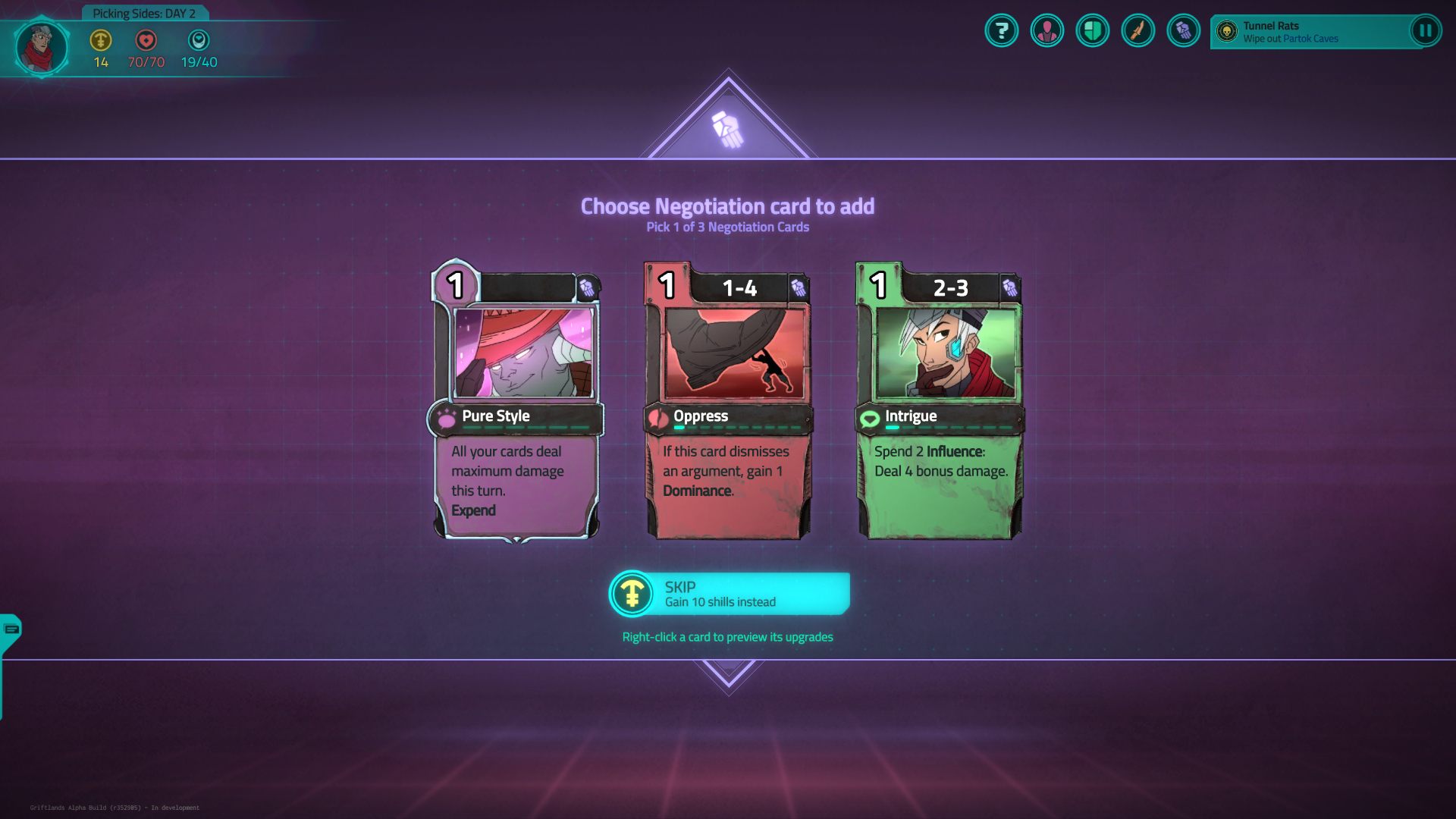
A good deck should not have too many cards. The smaller the set, the greater the probability that you will choose a card or set of cards that can be used to cause lots of damage.
There are two types of negotiation deck. The first one depends on using Diplomacy cards, those with a green background. The second one is based on Hostility cards, red background. This division originates from the evolution of the basic card which is "Sal's Instincts". It has 2 stunts that work well with one of the two sets of cards.
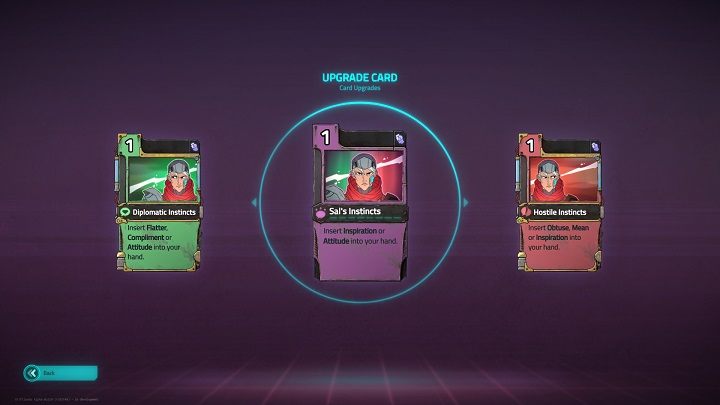
Because of this card it is good to decide which style you want to play from the very beginning. I can see from experience that both decks work well as long as you have good cards. Also, remember not to stuff and overload the decks with unnecessary cards. However, if you have any card you want to get rid of, you have 3 options. The first is to remove it for a fee on the Roadside Market. The basic fee is 50 shils, but it may be different because of our relationship with the seller. Another option is to remove the card in the form of payment for the task. After completing it you can choose from which deck you want to remove one card. The last way is to keep the card in your deck, when you play it enough times you will get the possibility to evolve it. One of these evolutions may be a possibility to destroy it after it's been played. This is particularly common for cards in the basic set. At the beginning I used it for Hostility group cards myself, building a deck from Diplomacy cards.
The first deck consists in earning Influence points that enhances cards in this group to deal maximum damage. These points reinforce your cards from the Diplomacy group too. The second one is to gain Domination points, which add one point of damage to Hostility group cards.
Things are different for duel decks. Here you do not build a deck of cards on a specific set of cards but on the basis of a unique status. It's about Attack cards, which have Combo or Bleed in their description. As before, it applies to the cards from the basic set, that is, "Sal's daggers". This card has 2 evolutions, one of which works well with Combo points and the other with Bleed points.
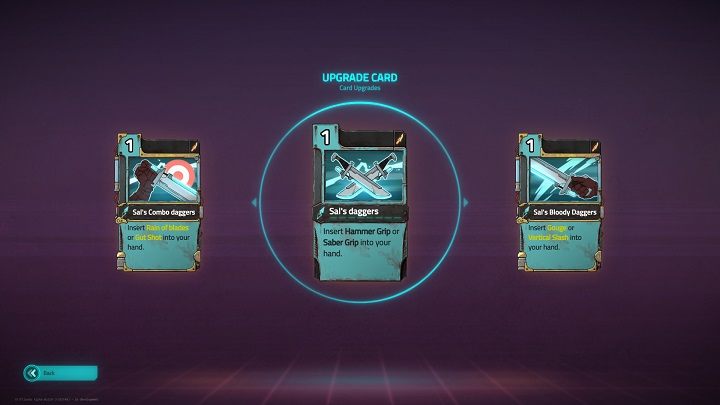
The first deck consists in earning Combo Points, which you can use to play additional card skills. They are also used to deal large amounts of damage with Finisher cards. The second deck uses the Bleed points inflicted to your opponent. When playing this deck you have to be careful not to mistakenly kill your opponent, I did it myself several times.
You are not permitted to copy any image, text or info from this page. This site is not associated with and/or endorsed by the developers and the publishers. All logos and images are copyrighted by their respective owners.
Copyright © 2000 - 2025 Webedia Polska SA for gamepressure.com, unofficial game guides, walkthroughs, secrets, game tips, maps & strategies for top games.
